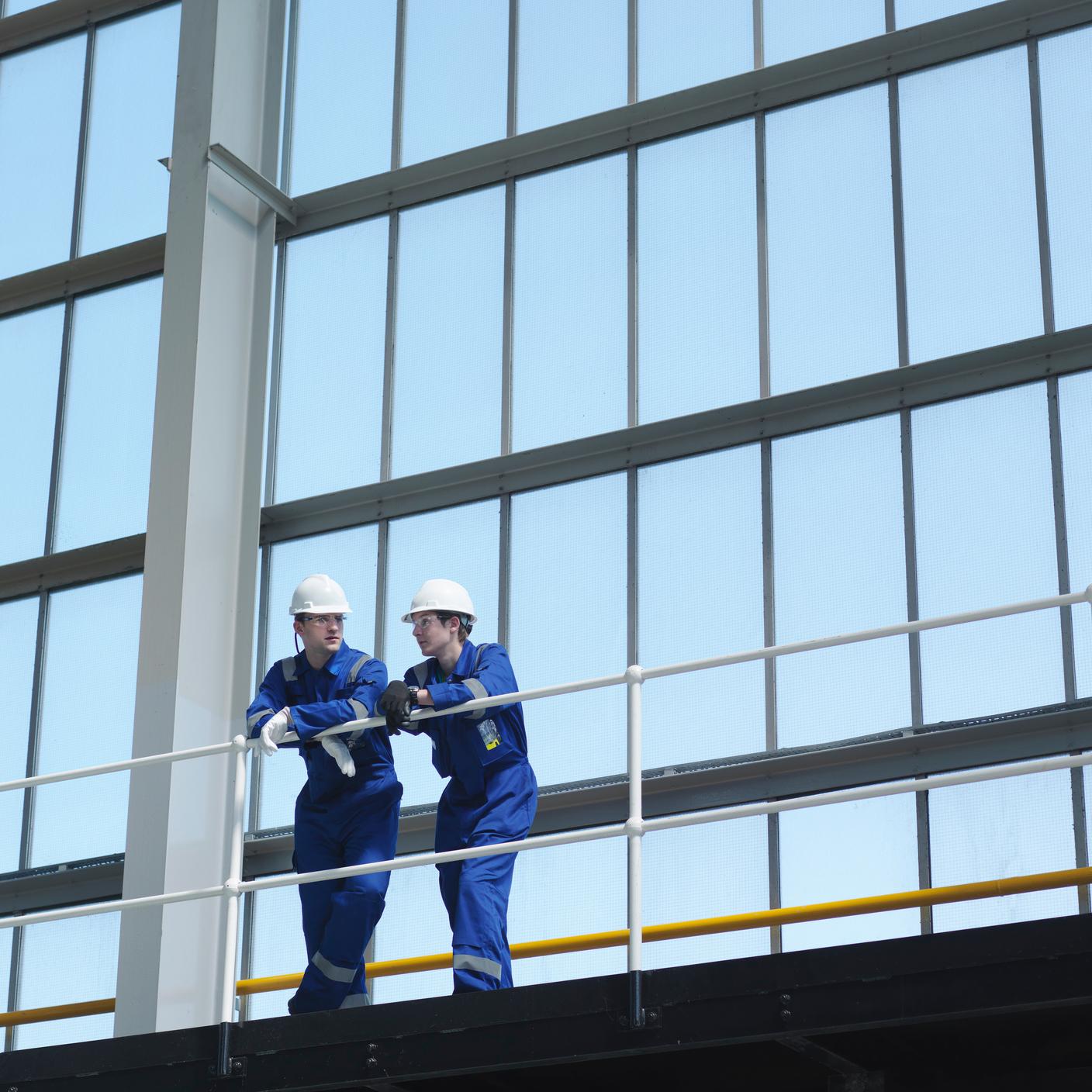Introduction
The impacts of climate change on businesses, society, and individuals globally underscore the urgent need to shift towards a low-carbon economy. If current rates of emissions continue, global temperatures may increase by 2.8°C come the end of the century.
The construction sector, responsible for approximately 40% of global greenhouse gas (GHG) emissions, stands pivotal in this transition. However, achieving net zero emissions by 2050 will demand innovation in design, materials, and construction processes.
The importance of standards in driving sustainability
Standards act as a catalyst for change, providing a framework for best practices, consistency, and accountability across all industries, including the built environment.
They play a vital role in driving sustainability and innovation in key areas:
• Decarbonization: Standards address the carbon footprint of buildings and infrastructure, providing guidelines for reducing emissions through energy efficiency, renewable energy integration, and carbon management.
• Circular economy: Standards promote the adoption of circular economy principles, reducing environmental impact through resource efficiency, waste reduction, and the reuse/recycling of materials.
• Resilience and adaptation: Standards enhance the resiliency and adaptability of buildings and infrastructure to climate change, providing guidance on climate-responsive design, disaster preparedness, and the integration of nature-based solutions.
• Collaboration and integration: Standards foster collaboration and knowledge sharing among stakeholders in the built environment, enabling the integration of sustainability considerations across the value chain.
The role of PAS 2080 in reducing carbon
PAS 2080, the world's first standard for carbon management in buildings and infrastructure, plays a significant role in promoting sustainability in the built environment sector, establishing responsibilities and data sharing protocols that streamline collaboration.
Industry leaders, such as Costain, Skanska, and HS2, have made remarkable strides in reducing CO2 emissions through implementing PAS 2080. For instance, Costain has achieved projected savings of 70,000 tonnes of CO2 emissions by utilizing a vegetable oil-based diesel alternative. Additionally, it has successfully cut 2,000 tonnes of CO2 emissions through the removal of 35,000 lorry movements.
Another notable success story is Skanska's resurfacing scheme at M5 Junction 27-28 in Willand. Initially estimated to cost £4.5 million, Skanska halved the cost while reducing the carbon footprint by 23%. This was accomplished through resource optimization, showcasing Skanska's commitment to finding innovative solutions that deliver both economic and environmental benefits.
The implementation of PAS 2080, which emphasizes leadership, collaboration, and the interconnectedness between infrastructure and buildings, has enabled companies like Skanska to achieve significant reductions in both costs and carbon emissions. These achievements underscore the transformative potential of sustainable practices when embraced by industry leaders.
Limiting expenditure is a significant ongoing consideration for stakeholders across the built environment. Carbon-reduction initiatives can often drive cost savings throughout project lifecycles.
Examples of efficiencies
• Balfour Beatty Rail's Thameslink signal structures project stands as a notable example of achieving significant reductions in waste, cost, and material usage. Through design re-evaluation and modification, Balfour Beatty Rail eliminated the need for excavated soil removal from the site. Additionally, thanks to the modified proposal, the demolition of a parapet wall was no longer necessary. The project achieved these outcomes by optimizing the design of new cantilever structures and incorporating existing gantry structures. Balfour Beatty Rail's success demonstrates the benefits of re-evaluating and adapting designs to maximize efficiency and sustainability in construction projects. Results: 60% reduction in carbon footprint and projected costs versus the original proposal.
• Costain and Tarmac's Heysham-to-M6 road project in Lancashire showcases the benefits that can come from close collaboration and strategic decision-making in construction. The two companies engaged for two years ahead of the project's commencement, fostering a deeper understanding of their respective operations to enable effective integration. By making strategic decisions spanning everything from quarrying practices to vehicles routes prior to construction, the project was able to optimize processes and minimize waste. This proactive approach to planning and coordination showcases the importance of early collaboration and thoughtful decision-making in achieving efficiency and sustainability in construction projects. Results: 25% reduction in aggregate tonnage and ready-mix concrete, and 21% CO2 emissions saving.
Standards inspire innovation
Standards also drive innovation in the built environment. They encourage research and development, foster the adoption of innovative solutions, and promote continuous improvement.
Moreover, standards ensure that new technologies and approaches meet established criteria for performance, safety, and environmental impact. This instils confidence in stakeholders and facilitates market acceptance, whilst also accelerating the adoption of innovative solutions.
The following examples illustrate how organisations are integrating clever design and low-carbon innovations into their business practices, limiting material usage, and driving down emissions:
• Retrofitting has emerged as a key approach in decarbonizing existing buildings. One notable example is the GenZero initiative, a research project supported by the Department for Education (DfE) and Innovate UK, which aimed to establish a new ultra-low carbon building standard for schools. The GenZero approach involved collaborating with construction innovators to develop a platform solution for manufacturing and assembly, with a digitally designed standard kit of parts. By prioritizing UK-sourced timber, GenZero achieved an impressive 35% reduction in timber consumption compared to similar buildings. This outcome not only highlights the potential of sustainable construction practices but also the importance of utilizing locally sourced materials.
• Smart buildings, can be equipped with technologies that drive carbon reductions and optimize energy consumption. These include consumption-monitoring proptech, data-driven property management software, electricity-conserving systems, occupancy-responsive HVAC, and predictive digital twin technology. By utilizing data-driven insights, smart buildings enhance energy efficiency and contribute to a more sustainable future. The Hammerbrooklyn Pavilion in Hamburg exemplifies the concept of smart and connected buildings by harnessing sensor technology and Internet of Things (IoT) interfaces. Through sensors, the pavilion collects data on parameters such as temperature, oxygen levels, and occupancy that is then utilized to optimize energy usage. Notably, the pavilion also uses upcycled materials, with boardwalk planks salvaged from Hurricane Sandy in 2012 and a repurposed steel frame from the US Pavilion at Expo Milan 2015 incorporated into its construction. The combination of innovative sensor technology, IoT interfaces, and eco-friendly materials represents a forward-thinking approach to building design that prioritizes energy efficiency and environmental sustainability.
• The use of low-carbon and waste-derived materials. Finding innovative solutions to decarbonize key construction materials is crucial for sustainability. A notable advancement in this area is the release of BSI Flex 350 V1.0:2023-10 – a flexible standard that marks a significant milestone in decarbonizing the concrete sector. Guiding construction businesses on lower carbon concrete alternatives, BSI Flex 350 V1.0:2023-10 stands out due to its performance-based provisions, allowing for quicker updates and responses to environmental challenges. This flexibility enables the concrete sector to adapt to evolving technologies and practices more efficiently.
• In addition to BSI Flex 350, other key standards related to concrete include BS 8500-1 and BS 8500-2. These standards, which provide composition-based requirements for specifying concrete, now include modifications to enable the specification of lower carbon concretes. These updates support industry efforts to reduce the carbon footprint of concrete, and have expanded the range of lower carbon options available for architects and engineers.
• Additionally, the use of low-carbon and waste-derived materials, like mining tailings and ashes, in 3D printing applications has shown promising results. This includes a 75% reduction in material use and 60% decrease in CO2 emissions.
The importance of policy direction, investment incentives and coordination
For innovation to G1thrive in the built environment, a supportive policy framework, investment incentives, and coordinated efforts are crucial. The Construction Playbook, published by the UK government, provides key policies and guidance for assessing, procuring, and delivering public works projects and programmes. It captures commercial best practices and sector reforms, outlining the government's expectations for engaging contracting authorities, suppliers, and the supply chain. This playbook serves as a foundation for driving innovation and sustainability in the construction industry.
Governments and regulatory bodies play a vital role in setting sustainability targets, implementing regulations, and providing financial support for R&D. By establishing clear guidelines and standards, they create an enabling environment for innovation and sustainable practices.
Collaboration among industry leaders, research institutions, government agencies, and standard-setting bodies is also essential for driving innovation and sustainability in the built environment sector. It fosters knowledge sharing, resource pooling, and joint efforts to address sustainability challenges.
Conclusion
Standards play a pivotal role in driving sustainability and innovation in the built environment. By adhering to standards, the sector can reduce carbon emissions, optimize resource use, and enhance resilience to climate change impacts.
BSI connects construction industry stakeholders to establish priorities for consensus-based best practices. We bring together industry experts, government bodies, research institutions, and other organizations to develop key standards and guidelines. Through BSI's initiatives, stakeholders can stay informed about industry advancements, exchange ideas, and learn from each other's experiences.
As the impacts of climate change grow, the built environment sector must embrace innovation, leverage standards, and collaborate across the value chain. In doing so, we can build a sustainable future with resilient infrastructure that benefits both people and the planet.







